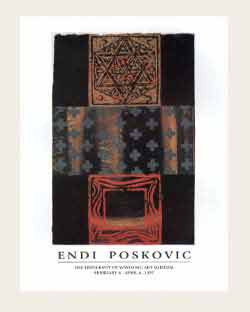Endi Poskovic: Recent Work
The somber cruciforms and dense, expressive strata of Endi Poskovic's monotypes are easy to look at but difficult to pin down. These handsome, powerful works at first seem immediately accessible; on further examination, their complexity unfolds. Undoubtedly, Poskovic is a technically gifted printmaker, a restrained but expert colorist, and an innovative manipulator of simple imagery. He is also deeply aware of the double-edged authority of signs. The signs in question are religious and architectural motifs from the culture and iconography of Poskovic's Bosnian homeland, motifs that have been recontextualized and transformed.
Much has been made of the cross-cultural aspects of Poskovic's art--the fact that he provides a setting where the emblems and architecture of four major religions coexist peacefully (at least in a graphic sense). Metaphorically, he could be dramatizing possibilities for reconciliation to cultural diversity or, conversely, underscoring the problematic nature of over-investment in the power of icons. But I think this "East meets West" aspect of Poskovic's oeuvre has been seriously overstated in most criticism of his work. Rather than employing such symbols in the naive sense that they have universally understood meanings, Poskovic removes them to a politically neutral, yet formally expressive context, underlining the democratic nature of modernist strategies. Each visual component in these prints, whether it is a star, a cross, or the etched imprint of Poskovic's blue jeans, is both autonomous and insignificant. They are structural elements which have been removed from sociopolitically charged contexts and now they hold our attention as suggestive forms, rather than obvious symbols.

To me, the forms suggest much more about the history of modernist abstraction
and its contemporary possibilities than they do about sociopolitical realities.
In a balanced dynamic of stylized geometric forms against a background
of expressive markings, works such as Sarajevo Haggadah have been
curiously emptied of topical significance--in spite of their evocative
titles. Poskovic uses forms with ancient and universal significance as
tools to explore the modernist vocabulary: the spontaneous improvisation
of abstract expressionism, the geometric repetition of minimalism, even
the compositional push-pull dynamics of such early innovators as Hans
Hoffman. To add another layer to Poskovic's methodology, we must remember
that he undertakes these explorations as a printmaker. Like Jasper Johns,
who is certainly an inspiration, Poskovic chooses specific subject matter
so that subject matter ceases to be an issue. It leaves the artist free
to experiment. But rather than using preexisting imagery from American
secular culture, as Johns did, Poskovic chooses equally familiar imagery
from a different category of icons. What remains important is how the
subject is transformed, rather than the subject itself.
Again like Johns--and many other printmakers--Poskovic is entranced with the possibilities for gradual change and variation within the printmaking process, particularly lithography. In the Europa series of lithographs, crosses become hearts, stars become spheres, and straightforward geometric forms are gradually worked until they become dark explosions of gestural markings, while color alternately swells and recedes within the prints. A first state Europa print is usually a simple form or emblem; later states include drawing, stamping, washes of color, and other alterations that take place either through printmaking or hand processes. In the Europa series of linoleum reliefs, copious stamping adds a funky Pop feel to the solemn emblems; in his most recent work, Poskovic has capitalized on this effect, using "primitive" printmaking techniques to create buoyant, colorful prints, elegant but much more evocative of pop culture. For the student of printmaking, Poskovic offers everything a print can be, from a simple impression to a shimmering, multi-layered universe of complex imagery. Although Poskovic's interest in the appropriation of images and the shifting definitions of signs clearly demonstrates that his intellect is in the post-modern age, his enthusiastic explorations and alterations of printmaking technologies shows that at heart he is still a modernist pioneer, breaking through the carefully defined boundaries of reproductive methodologies.
But you need not be a print connoisseur to appreciate the work. I think viewers are drawn to Poskovic's work for a variety of reasons, some of which may seem opposed or contradictory. First, his subject matter is both familiar yet liberated; we appreciate the symbols and icons purely for their graphic power rather than feeling oppressed or trapped by their history and associations. Second, the compositions are powerfully focused combinations of sophisticated, elegant central images and cruder, gestural markings. The imagery engages the appreciation of the intellect while the less identifiable markings engage the participation of the emotions. There is still room in these works for our interpretations.
Finally, there is an indefinable quality within the prints expressed in the title of the series: Europa. Without going out too far on a limb of questionable generalizations, to American eyes these prints are invested with centuries of cultural history and sophistication. Evoking fragments of history and architecture, Poskovic alludes to a narrative that has been told over and over before without actually participating in the telling. Clearly, he has other, more contemporary priorities. Through investing the innovations of modernist pioneers such as Jasper Johns and Jackson Pollock with the nostalgic poetry of distant histories, Poskovic performs an act of transgressive impudence, an impudence only possible in the postmodern era.
University of Wyoming, 1997

